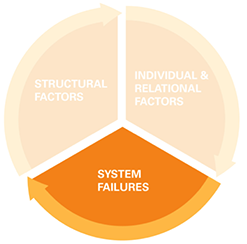
Child Welfare Systems:
While this system only directly affects youth, that population makes up 20% of shelter uses and youth homelessness often leads to adult homelessness. Research has shown that over 40% of homeless youth have been part of the child welfare system including adoption and foster care. The most important preventative issue is looking at how youth ‘age out’ of care.
Often, when youth reach 18 they are discharged from the child welfare system and have little access to continuing supports. It is important that youth, especially those who have been in care for a long time, are supported to develop into adulthood. Continuing supports –including residential foster care—until age 21 or higher is one method of prevention. Providing life skills training to youth as they prepare to move to independence is another. Creating opportunities for youth to gradually transition into independent living can also help prevent homelessness.
Another important child welfare issue is that of 16 and 17 year olds. Often, youth are not taken into care at that age and so they end of homeless with no supports from the child welfare system. Youth at that age are generally not ready to live independently. If they are no longer able to stay in the family home they should be supported in a gradual transition to independence.
Corrections:
Prevention in the corrections system is multi-faceted. For youth, many of the same issues that arise in the child welfare system arise in the corrections system. There is a need for support as they prepare to live independently.
For adults, there is a need to provide discharge planning to support a transition from incarceration to independence.
Part of the issue is the way discharge planning in our corrections system is set up. Discharge planning is only provided to people who have been convicted of a crime. In federal institutions this means pretty much everyone is given the support they need, or at least some of the supports that they need, to move on to housing. But in a provincial institution a large number of the inmates are being held ‘on remand’ which means they have been charged but not yet convicted of a crime. As a result, they are not provided with any discharge planning. However, long delays in court hearings and overcrowding in the jails means many people are discharged directly from court (with or without a conviction) and are not given an opportunity to access the supports they need to live independently.
Healthcare Institutions:
There are a couple distinct issues with healthcare discharges depending upon the type of facility. If a patient has been institutionalized for an extended period of time due to health issues it is incumbent upon the facility to ensure that they have a home to return to. This is particularly true if they have any kind of medical regimen that they need to follow: medication, appointments, wound care, sitz baths, bed-rest etc. Even if the individual hasn’t been hospitalized for an extended period of time someone at the hospital – social worker/counsellor, nurse or doctor – should also ensure that the patient’s home environment will meet their needs. Someone being released during the summer due to heat exhaustion shouldn’t be returning to a rooming house without air conditioning; other arrangements should be made.
Not all hospitalizations/health care stays are connected to physical health. Someone who has gone through an addictions treatment facility or a mental health related hospitalization also needs the safety and security that housing provides. If someone is discharged from one of these facilities into homelessness it may cause him or her to relapse.
